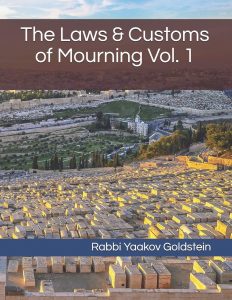11. The Tachrichin/Burial garments:[1]
The burial garments are called Tachrichin, as they are used to garb the dead.[2] These garments have extreme effect on the soul of the deceased, and one is thus not to swerve from any of the laws and regulations mentioned below, or from the community custom.[3] Not being careful in the above can lead to danger for the community.[4]
The cost and elegance:[5] One may not bury the deceased in expensive burial garments. This applies even if the deceased is a leader amongst Israel. [Nonetheless, the garments are to look nice, as whoever makes pleasant looking burial garments for the deceased shows that he believes in the resurrection, and he will be blessed.[6] In fact, Chazal state that the deceased will become resurrected wearing the clothing that he was buried in.[7] Accordingly, the custom of some is to purchase nice looking flax garments. Nonetheless, to purchase very extravagant burial garments is certainly forbidden.[8] If the burial garment is dirty, it is to be laundered.[9] If it is torn, it is to be sewn.[10]]
The color:[11] The custom is for all the burial garments to be white.
The material and production: From the letter of the law, the garment may be made of any material, including a mixture of Kilayim, wool and linen.[12] Nevertheless, it is customary to bury the dead in a linen garment [if possible[13]].[14] There is great Kabalistic meaning behind the wearing of linen, and doing so greatly benefits the soul of the deceased, turning all of his prosecuting angels to defense angels. It is imperative for this reason that no other material be mixed with the linen or be worn by the deceased. Hence the garment is to be sewed with linen strings.[15] It is customary for the burial garment to be woven by hand, and by Jewish women who are pure.[16] The garment is not to contain any pockets or knots.[17]
The number of garments:[18] Some are accustomed to dress the dead with three, or five, garments corresponding to the three/five soul levels. Others are accustomed to dress the dead with eight garments, corresponding to the eight garments worn by the Kohen Gadol. Each community is to follow their custom. The Chabad tradition is to dress the body of a man in six/seven garments: 1) shirt; 2) pants; 3) a turban that covers the head, neck and face; 4) Kittul; 5) belt; 6) Tallis 7) “Soveiv” wrapping [a white sheet].[19]
The Kittul:[20] It is customary to bury the dead in a Kittul.[21] The custom is to use the Kittul that he wore on Yom Kippur.[22] All the buttons are removed beforehand. This applies even if the Kittul is not made of linen. However, some are particular that the Kittul be made of linen.
Dressing the corpse:[23] A man may not dress the corpse of a woman, although a woman may dress the corpse of a man.[24] [The body is to be dried prior to dressing it.[25] The garment is not to be placed inside out and is not to have any of its parts folded. One is also to be careful that no part of the garment enters the mouth of the corpse.[26] While dressing the corpse, they are to have in mind that just as they are dressing the body, so too G-d is dressing the soul in Gan Eden.[27] When passing the clothing from one person to another, some are accustomed not to thank each other for it.[28] Some are accustomed to dress the dead in the same order as a Kohen, with the pants first and only then the shirt.[29] Others are accustomed to begin with the head and work their way down.[30] Each community is to follow their custom. The Chabad custom is like the former approach.[31] One is not to place two garments onto the body simultaneously.[32] The belt is not to be tied with a knot but is rather to be fastened with a bow.[33] It is tied a total of 13 times.[34] Some are accustomed to have the sons wrap the belt around the deceased.[35] The prayers written in the Sefer Mavor Yabok are recited while they dress the dead.[36] A list of prayers is recorded at the end of this chapter.]
_______________________________________________________________________[1] See Gesher Hachaim 10; Darkei Chesed 12; Nitei Gavriel Chapter 46
[2] Kol Bo Avel
[3] Beir Heiytiv 352:1
[4] See Beiry Heiytiv ibid in name of Sefer Chassidim 451 that when there is a plague in the city one may unbury the dead to see if any were buried with worn out clothing; See Darkei Chesed 12:11 regarding if they forgot to dress the deceased, or if one of the garments were forgotten.
[5] Michaber 352:1; Kilayim 9:1
The reason: This is due to Tikun Haolam, as the poor people cannot afford expensive garments. It is also due to that having expensive burial garments is considered a gesture of arrogance and Baal Tashchis. [Shach 352:1]
[6] Darkei Moshe and Derisha in name of Nemukei Yosef, brought in Shach 352:1; Kitzur SHU”A 197:1
[7] Miseches Semachos 9; Yerushalmi end of Kilayim; Aruch Hashulchan 352:2; See Kesubos 111b that the dead will be resurrected in their clothing
[8] Shach ibid; See however Beir Heiytiv 352:1 that for a wealthy person it is permitted based on his standard of dress
[9] Nitei Gavriel 46:5
[10] Nitei Gavriel 46:20
[11] Michaber 352:2; Tur 352; Ramban in Toras Hadam; Sefer Chassidim 733; Nitei Gavriel 46:21
[12] Michaber 301:7; 351:1; Mishneh Kilayim 4:9; Nidda 61b
The reason: As a dead person is not obligated in Mitzvos. [Taz 301:9; Rambam Kilayim 10:25; Rebbe Yochanon in Nidda ibid] Now, although by the resurrection he will awaken wearing the Shatnez clothing, some Poskim learn that by then the Mitzvos will be nullified. [Rav Yosef in Nidda ibid; Tosfos Nidda 61b; Tanya Igros Kodesh end of 26; See Poskim in Sdei Chemed Kelalil Mem 218; Divrei Chachamim 53] Alternatively, it is valid even according to those opinions who rule that the Mitzvos are eternal [Rashba; Ayin Beis 1:193], as by then the Mitzvos will not exist as a command but as an automatic fact of life, and therefore as soon as the person is resurrected, and even during the resurrection, the Kilayim will be removed in a miraculous way. [Rebbe in Kuntres Mitzvos Bitalos Liasid Lavo, printed in Shaar Hageulah 54; See Maharitz Chayos on Nidda ibid]
[13] See Gesher Hachaim p. 101; Darkei Chesed 12:2; Nitei Gavriel 46:19; See below regarding the Kittul and Tallis
[14] Shach 352:1; Levush 352; Tur 352 in name of Rambam Avel 4; Yalkut Reuveini Parshas Mikeitz, brought in Pischeiy Teshuvah 352:2; Gesher Hachaim 10:1; Darkei Chesed 12:1
[15] Yalkut Reuveini ibid; See Rambam Avel 4:1; Mavor Yabok Imrei Noam 21
[16] See Mavor Yabok Sifsei Emes 32; Divrei Malkiel 6:22; Gesher Hachaim 10:1; Darkei Chesed 12:3; Poskim in Nitei Gavriel 46:3 footnote 6-7
[17] Rokeiach 316; Mavor Yabok Sifsei Emes 6; Siddur Beis Oved; Chochmas Adam 157:8; Kitzur SHU”A 197:1; Gesher Hachaim 10:1; Darkei Chesed 12:4; Nitei Gavriel 46:6
[18] Nitei Gavriel 46:8; Gesher Hachaim 10:2 lists 8 garments, including gloves for a Kohen; See Darkei Chesed 12:5 for detailed Chabad custom
[19] Darkei Chesed p. 49
[20] Nitei Gavriel 47:1
[21] See Admur 610:9 that a Kittul is the clothing of the dead
[22] Kitzur SHU”A 197:1 regarding Tallis that on wore during davening; Teshuvah Meahava 3:349
[23] Michaber 352:3; See Gesher Hachaim 10:2 and Darkei Chesed 12:7-8 in great detail regarding the exact order of dress
[24] The reason: This is due to worry that the man may have erotic thoughts. However, a woman is not suspected of erotic thought to this extent. [Shach 352:1]
[25] Nitei Gavriel 46:6
[26] Nitei Gavriel 46:10
[27] Mavor Yabok Sifsei Rinanos 13; Chochmas Adam 157:8; Kitzur SHU”A 197:1; Nitei Gavriel 46:7
[28] Nitei Gavriel 46:9
[29] Seder Rechitza Hillel Hazakein; Siddur Besi Oveid that so is Sephardic custom; Order in Darkei Chesed p. 49: 1) Mitznefes; 2) pants; 3) shirt; 4) Kittul; 5) belt; Sefarim in Nitei Gavriel 46:12
[30] Sefarim in Nitei Gavriel 46:12
[31] See Darkei Chesed ibid footnote 11
[32] Nitei Gavriel 46:14; See Admur Kama 2:3; Basra 2:3; M”A 2:3; Arizal Shaar Hakavanos; However, see Darkei Chesed 12:7 that two people put on the pants at the same time
[33] Mavor Yabok Sefas Emes 6
[34] Darkei Chesed p. 170
[35] Aruch Hashulchan 352:2; Darkei Chesed 170 that so is custom of some even for the mother; Ishkavta Derebbe p. 102 that so did the Rebbe Rayatz to his father the Rebbe Rashab; See Nitei Gavriel 47:17-18 and footnote 34 that so did the Rebbe for his mother
[36] Gesher Hachaim 10:3; See Mavor Yabok Sifsei Rinanos 14 that the Sages did not prohibit the recital of prayers or words of Torah near a corpse; Vetzaruch Iyun regarding prohibition of learning Torah near a gravesite. See Nitei Gavriel 46:17 regarding the order followed for bodies of women and children r”l



Leave A Comment?
You must be logged in to post a comment.